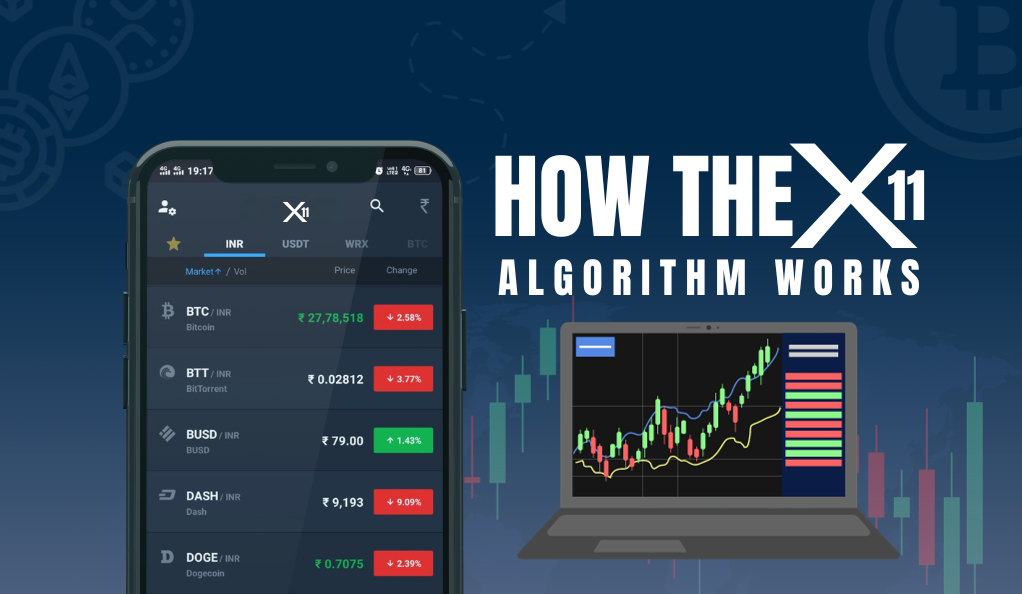In the ever-evolving world of digital currencies, the quest for enhanced security, efficiency, and innovation remains paramount. Among the myriad of cryptographic algorithms that have emerged, the X11 algorithm stands out, not just for its unique structure but also for its profound impact on the cryptocurrency landscape. This section delves into the origins of X11, its significance, and its role in shaping modern digital computing.
A Brief History of X11
The X11 algorithm, often simply referred to as X11, was developed by Evan Duffield and was initially implemented into the Darkcoin protocol, which was later renamed to DASH. The inception of X11 was driven by the need for a more secure and energy-efficient hashing algorithm, especially in the wake of increasing concerns about the vulnerabilities of existing algorithms. Unlike its predecessors, X11 wasn’t just a singular hashing function; it was a combination of 11 different cryptographic hash functions, hence the name “X11”.
| Hash Function | Brief Description |
|---|---|
| BLAKE | Known for its high speed on 64-bit platforms. |
| BMW (BLUE MIDNIGHT WISH) | Designed for enhanced security and performance. |
| Grøstl | Provides security against differential and linear cryptanalysis. |
| JH | A finalist in the NIST hash function competition. |
| Keccak | The foundation for the SHA-3 standard. |
| Skein | Uses a tweakable block cipher. |
| Luffa | Suitable for hardware and software implementations. |
| CubeHash | Designed for parallelism and security. |
| SHAvite-3 | Efficient on a variety of platforms. |
| SIMD | Optimized for parallel processing. |
| ECHO | A second-round candidate in the NIST competition. |
The Role of X11 in Modern Digital Computing
As cryptocurrencies rapidly evolved since the creation of Bitcoin, the need for secure and efficient hashing algorithms became more pressing. X11, with its innovative approach, quickly gained attention in the crypto community. Its sequence of 11 cryptographic hash functions meant that when a value was submitted, it underwent a series of hash productions, each feeding into the next, culminating in a final hash. This not only increased security but also made it computationally expensive and time-consuming to launch attacks on the network.
Furthermore, the X11 algorithm played a pivotal role in addressing some of the most pressing concerns in the crypto world, such as energy consumption. Traditional proof-of-work algorithms were notorious for their energy-intensive mining processes. In contrast, X11 offered an energy-efficient alternative, significantly reducing the power consumption required for mining.
In conclusion, the X11 algorithm, with its unique combination of 11 hash functions, has carved a niche for itself in the world of digital currencies. Its emphasis on security, energy efficiency, and robustness has made it a preferred choice for many in the crypto community, laying the foundation for its integration into decentralized wallets, which we will explore in the subsequent sections.
How the X11 Algorithm Works

The X11 algorithm, with its intricate design and multi-layered cryptographic approach, has piqued the interest of many in the crypto community. But what makes it so unique? And how does it function differently from other hashing algorithms? In this section, we’ll unravel the workings of the X11 algorithm, shedding light on its sequence and the rationale behind its design.
A Sequence of 11 Cryptographic Hash Functions
At its core, the X11 algorithm is a chain of 11 distinct cryptographic hash functions. When a value, such as a transaction or a block of data, is introduced into the system, it doesn’t just pass through a single hashing process. Instead, it undergoes a series of transformations, each handled by a different hash function. The output of one function becomes the input for the next, creating a cascading effect.
This sequence is meticulously designed to ensure that the final hash value is not only unique but also resistant to any pre-image or collision attacks. In simpler terms, it’s nearly impossible to deduce the original input from the final hash or find two different inputs that produce the same hash.
The Chaining Process of X11:
- Step 1 – BLAKE: Produces Hash 1
- Step 2 – BMW (BLUE MIDNIGHT WISH): Produces Hash 2
- Step 3 – Grøstl: Produces Hash 3
- …
- Step 11 – ECHO: Produces the Final Hash
The Rationale Behind the Chaining Approach
One might wonder, why employ such a complex system when a single hash function could suffice? The answer lies in the principle of layered security. By utilizing multiple hash functions, X11 ensures that even if a vulnerability is discovered in one function, the overall integrity of the system remains uncompromised. This multi-faceted approach significantly heightens the security of the algorithm.
Moreover, the chaining process provides an added layer of unpredictability. Since the output of one function influences the input of the next, any attempt to predict or manipulate the final hash becomes exponentially more challenging.
Enhanced Security and Efficiency
The X11 algorithm’s design inherently makes it resistant to parallel processing attacks. Since each hash function has its unique properties and computational requirements, it becomes exceedingly difficult for an attacker to optimize a hardware solution that can effectively compromise the system.
Furthermore, the diversity of the hash functions used ensures that the algorithm remains efficient. Some functions are optimized for speed, while others prioritize security, creating a balanced system that is both fast and secure.
Benefits of Using X11 in Decentralized Wallets
In the realm of digital currencies, the choice of a hashing algorithm can significantly influence the overall performance, security, and user experience of a platform. With the rise of decentralized wallets, which offer users more control over their funds without relying on centralized entities, the importance of a robust and efficient hashing algorithm becomes even more pronounced. In this section, we’ll explore the myriad benefits that the X11 algorithm brings to decentralized wallets.
Enhanced Security
Arguably the most significant advantage of the X11 algorithm is the heightened security it offers. By chaining 11 different cryptographic hash functions, X11 ensures that even if one function is compromised, the overall system remains secure. This multi-layered approach is particularly beneficial for decentralized wallets, where security is paramount.
Security Features of X11:
- Multiple Hash Functions: Reduces vulnerability points.
- Resistance to Parallel Processing Attacks: Makes hardware attacks more challenging.
- Unpredictable Chaining: Adds complexity to potential breaches.
Energy Efficiency
Traditional proof-of-work algorithms, like Bitcoin’s SHA-256, are known for their high energy consumption. In contrast, X11 provides a more eco-friendly solution. Its design ensures that mining processes consume less power, reducing the environmental impact and making it a more sustainable choice for decentralized wallets.
Low Power Cost
Beyond environmental concerns, the energy efficiency of X11 also translates to tangible cost savings for miners. With reduced power consumption, miners face lower electricity bills, making the mining process more profitable. This is especially beneficial for decentralized wallet users who might engage in staking or other consensus mechanisms.
Adaptability and Future-Proofing
The modular nature of X11, with its 11 hash functions, means that it can be easily updated or modified. If a vulnerability is discovered in one of the hash functions, it can be replaced without overhauling the entire system. This adaptability ensures that X11 remains relevant and secure as cryptographic research advances.
Reduced Heat Generation
Miners using the X11 algorithm have reported that their hardware, especially GPUs, runs cooler compared to when they mine using other algorithms. This not only extends the lifespan of the mining equipment but also reduces the risk of hardware failures, ensuring uninterrupted operations for decentralized wallet users.
Fairer Mining
The design of X11 levels the playing field between different types of mining equipment. High-end CPUs and GPUs offer similar returns, promoting a more decentralized mining community. This is in stark contrast to some other algorithms where specific hardware, like ASICs, can dominate, leading to centralization.
Potential Drawbacks and Concerns of X11 in Decentralized Wallets
While the X11 algorithm boasts a plethora of benefits, especially in the context of decentralized wallets, it’s essential to approach it with a balanced perspective. Like any technology, X11 isn’t without its challenges and potential drawbacks. In this section, we’ll delve into some concerns associated with the X11 algorithm, providing a comprehensive understanding of its implications.
Complexity of Implementation
The very feature that makes X11 stand out—its chaining of 11 cryptographic hash functions—also makes it relatively complex. Implementing and maintaining such a multi-faceted system requires a deeper understanding of each hash function and how they interplay. This complexity can pose challenges, especially for newer platforms or those with limited technical expertise.
Market Adoption and Compatibility Issues
Given its unique structure, X11 may not be as widely adopted as some other algorithms. This limited adoption can lead to compatibility issues, especially when integrating with platforms or services that do not support the X11 algorithm. For decentralized wallets, this might mean fewer partnerships or integrations with other platforms.
Potential for Centralization with ASIC Mining
While X11 was initially resistant to ASIC (Application-Specific Integrated Circuit) mining, over time, ASICs designed specifically for X11 have emerged. These powerful mining devices can outperform traditional CPUs and GPUs, leading to potential centralization as ASIC miners dominate the network. This goes against the very ethos of decentralization that many in the crypto community champion.
Concerns Associated with X11:
- Complexity: Challenges in implementation and maintenance.
- Limited Adoption: Potential compatibility and integration issues.
- ASIC Mining: Risk of centralization and reduced decentralization.
Evolution of Cryptographic Research

The field of cryptography is dynamic, with new research and findings emerging regularly. While X11’s modular design allows for updates, there’s always a risk that newer, more efficient, or secure algorithms could overshadow it. Decentralized wallets relying solely on X11 might then face challenges in staying current and competitive.
Resource Intensiveness
Despite its energy efficiency in mining, the X11 algorithm, with its 11 hash functions, can be resource-intensive in other scenarios, especially during multiple rapid transactions or validations. This could lead to delays or increased computational requirements in certain situations.
Security Implications of X11 in Decentralized Wallets
The realm of digital currencies is fraught with security challenges. From potential hacks to 51% attacks, the need for robust security mechanisms is undeniable. The X11 algorithm, with its unique design, offers a series of security benefits, especially for decentralized wallets. However, understanding its full security implications requires a deep dive. In this section, we’ll explore the security strengths and potential vulnerabilities associated with the X11 algorithm.
The Complexity of 51% Attacks
A 51% attack, where a single entity gains control of the majority of a network’s mining power, poses a significant threat to many cryptocurrencies. Such an attack allows the malicious actor to double-spend coins, undermining the integrity of the entire system. The X11 algorithm, with its sequence of 11 cryptographic hash functions, makes launching a 51% attack computationally expensive and time-consuming. The attacker would need to compromise not just one, but multiple hash functions, adding layers of complexity to any potential attack.
Network Integrity and the Role of Masternodes
Beyond the inherent security of the X11 algorithm, the integration of masternodes in networks using X11 further bolsters security. Masternodes, which perform advanced functions beyond regular nodes, add an additional layer of security, network stability, and enhanced transaction privacy. Their presence ensures faster transaction confirmations and reduces the risk of double-spending.
Security Features Bolstered by Masternodes:
- Instant Transactions: Enables near-instant transactions, reducing the risk of double-spending.
- Enhanced Privacy: Transactions are obfuscated, ensuring greater privacy for users.
- Decentralized Governance: Masternode operators can vote on network changes, promoting true decentralization.
Resistance to ASIC Dominance
While ASICs designed for X11 have emerged, the algorithm’s design ensures that the advantage they offer over traditional CPUs and GPUs isn’t as pronounced as in some other algorithms. This balance reduces the risk of centralization, ensuring that the network remains decentralized and secure.
Adaptability to Cryptographic Vulnerabilities
The modular nature of X11, comprising 11 distinct hash functions, means that if a vulnerability is discovered in one function, it can be replaced without overhauling the entire system. This adaptability is crucial in the ever-evolving field of cryptography, ensuring that the algorithm remains resilient to emerging threats.
Potential Vulnerabilities
No system is entirely invulnerable. The complexity of X11, while a strength, can also be a potential point of vulnerability. Managing and maintaining the integrity of 11 hash functions requires diligence. Additionally, as with any algorithm, there’s always the risk of unforeseen vulnerabilities emerging over time.
Masternodes: The Extra Layer of Security in X11 Networks

In the intricate web of cryptographic systems and decentralized networks, masternodes have emerged as a pivotal component, especially in networks utilizing the X11 algorithm. These specialized nodes go beyond the traditional functions of regular nodes, offering enhanced features and bolstering the security and efficiency of the network. In this section, we’ll delve into the world of masternodes, understanding their role, benefits, and significance in X11-based decentralized wallets.
What are Masternodes?
Masternodes can be envisioned as dedicated servers within a cryptocurrency network that perform specialized tasks. While regular nodes relay transactions and maintain the blockchain’s integrity, masternodes take on additional responsibilities, such as facilitating instant transactions, participating in consensus mechanisms, and more.
Functions and Benefits of Masternodes
Masternodes are not just about added security; they bring a plethora of features to the table:
- Instant Transactions: One of the standout features of masternodes is the ability to process transactions almost instantly. This is crucial for real-time applications and ensures a seamless user experience.
- Enhanced Transaction Privacy: Masternodes can obfuscate transactions, ensuring that details remain private and cannot be traced back, adding an extra layer of privacy to users.
- Decentralized Governance: Masternodes play a pivotal role in the decision-making process of the network. They can vote on budgetary allocations, potential network changes, and other crucial decisions, ensuring that the network remains truly decentralized.
Incentives for Masternode Operators
Operating a masternode requires an investment, both in terms of the collateral (a certain number of coins held as a stake) and the infrastructure (a dedicated server, IP address, etc.). To compensate for this, masternode operators receive rewards, typically a portion of the block reward. This incentivizes individuals to set up and maintain masternodes, ensuring the network’s health and stability.
The Synergy between X11 and Masternodes
The X11 algorithm, with its focus on security and efficiency, pairs exceptionally well with the concept of masternodes. The algorithm’s resistance to certain types of attacks, combined with the added security layer from masternodes, creates a fortified environment. This synergy ensures that decentralized wallets operating on X11 networks with masternodes offer users both functionality and peace of mind.
Challenges and Considerations
While masternodes offer numerous benefits, potential operators should be aware of the challenges. The initial investment can be substantial, and there’s a need for technical know-how to set up and maintain a masternode. Additionally, as with any investment, there’s a risk-reward ratio to consider, especially in the volatile world of cryptocurrencies.
Decentralized Governance and the Role of Masternode Operators in X11 Networks
In the decentralized world of cryptocurrencies, governance—the process of making decisions that affect the network—becomes a critical concern. Traditional centralized systems have a clear hierarchy for decision-making, but how do decentralized networks, especially those using the X11 algorithm, navigate this complex terrain? The answer lies in the innovative concept of decentralized governance, with masternode operators playing a pivotal role. In this section, we’ll explore this governance model and its implications for X11-based networks.
Understanding Decentralized Governance
Decentralized governance refers to the decision-making process in a decentralized network, where no single entity has unilateral control. Instead, decisions are made collectively, based on consensus mechanisms, ensuring that the network remains transparent, fair, and truly decentralized.
The Concept of a Decentralized Autonomous Organization (DAO)
At the heart of decentralized governance lies the concept of a DAO or Decentralized Autonomous Organization. A DAO operates based on pre-defined rules encoded in smart contracts. It allows for automated, transparent decision-making, with stakeholders (like masternode operators) having a say in the process.
Voting and Decision-making Processes
In X11 networks that employ masternodes, these operators often have voting rights. Here’s how the process typically unfolds:
- Proposal Submission: Any network participant can submit a proposal, detailing a potential change, feature addition, or any other network-related decision.
- Masternode Review: Masternode operators review these proposals. Given their stake and commitment to the network, they’re considered informed and responsible voters.
- Voting: Masternode operators cast their votes on the proposal. A proposal might require a simple majority or a more significant consensus, depending on the network’s rules.
- Implementation: If a proposal garners enough support, it’s implemented in the network.
Benefits of Decentralized Governance in X11 Networks
Decentralized governance in X11 networks offers a myriad of advantages that cater to the evolving needs of the digital currency landscape. One of the standout benefits is transparency. Every decision made within the network is open and accessible, ensuring that stakeholders are always in the loop. This transparency is complemented by the inclusivity of the governance model. Multiple stakeholders, especially masternode operators, have a voice in the decision-making process, ensuring that a diverse range of perspectives are considered. Furthermore, the flexibility inherent in this governance model allows the network to adapt and evolve based on collective decisions. This ensures that the network remains agile, responsive, and in tune with the needs of its users. As the digital currency ecosystem continues to grow and change, such decentralized governance models, especially in X11 networks, will play a crucial role in ensuring that platforms remain user-centric, transparent, and adaptable.
Challenges of Decentralized Governance
While the model offers numerous benefits, it’s not without challenges:
- Coordination: Achieving consensus in a large, diverse group can be challenging.
- Potential for Gridlock: Differing opinions can lead to decision-making paralysis.
- Risk of Centralization: If a few masternode operators accumulate significant voting power, it could lead to centralization, undermining the very ethos of decentralization.
Conclusion: The Future of X11 and Decentralized Wallets
As the digital landscape rapidly evolves, the X11 algorithm stands out as a beacon of innovation, security, and adaptability. Its multi-layered cryptographic approach, combined with the growing emphasis on decentralization, positions it at the forefront of the next wave of digital currency advancements. The unique features of X11, from its energy efficiency to its modular design, ensure its alignment with future digital computing needs. Furthermore, the rise of decentralized wallets, underpinned by X11, signifies a shift towards greater user control, privacy, and transparency. The role of masternodes and the decentralized governance model further amplifies this trend, empowering users to have a voice in the platforms they engage with.
However, the path forward is not without challenges. Potential centralization, evolving cryptographic threats, and market adoption barriers must be navigated with care. Yet, these challenges also present opportunities for growth, refinement, and innovation. The future of X11 isn’t solely in the realm of developers or masternode operators; it’s a collective journey where the community plays a pivotal role. Through collaboration, feedback, and active participation, the X11 ecosystem is poised to evolve in a direction that resonates with its users’ needs, aspirations, and the very ethos of decentralization.
At axerunners.com, our goal is to furnish well-rounded and trustworthy information regarding cryptocurrency, finance, trading, and stocks. Nonetheless, we avoid providing financial advice and instead encourage users to conduct their own research and meticulous verification.
Read More










